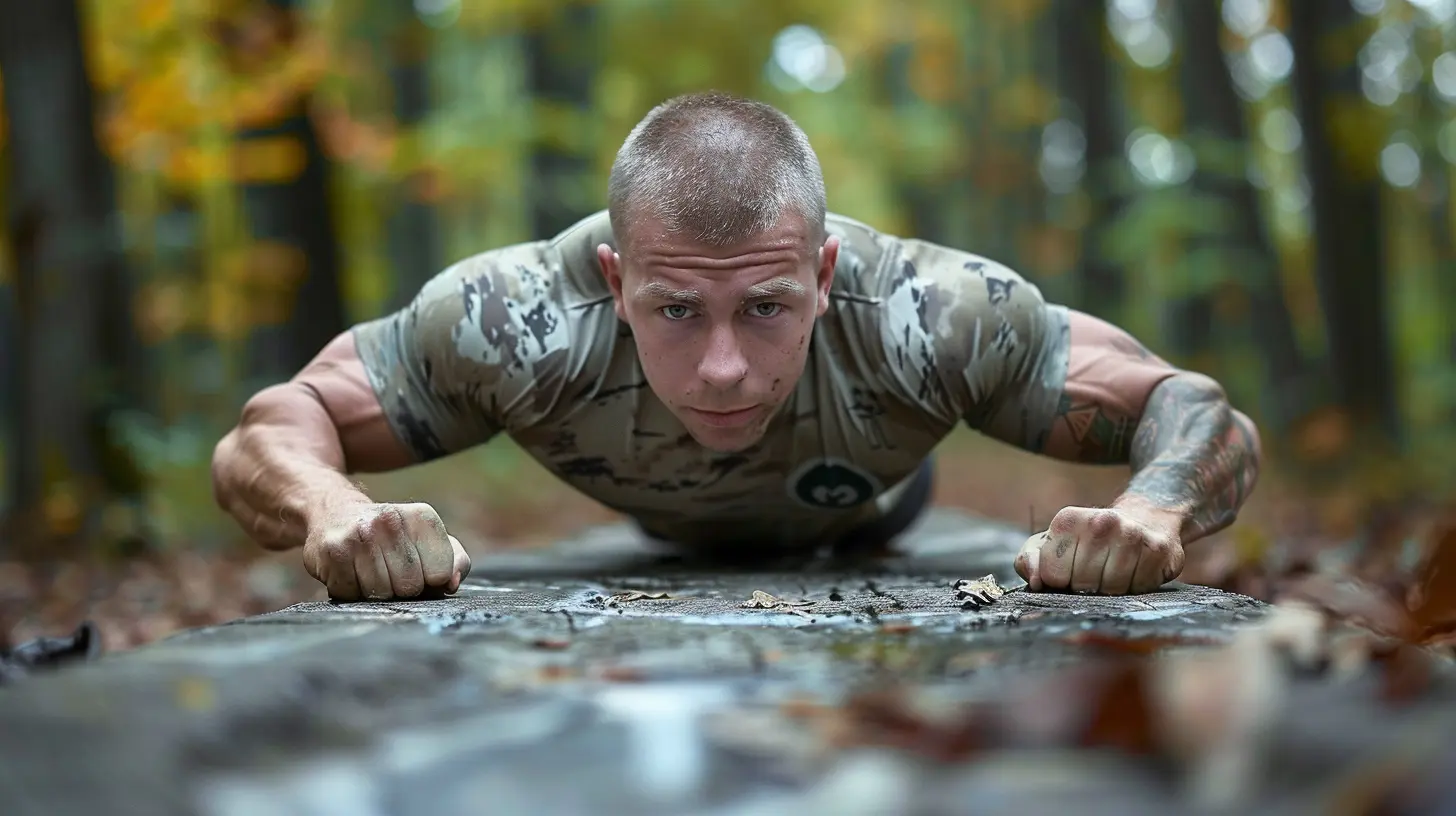Is Bodyweight Training Enough for Strength Gains?
7 October 2025
Let’s be real—when most people think about building serious strength, they imagine heavily stacked barbells, clanging metal plates, and a gym full of grunting lifters. But here’s the burning question: Is bodyweight training enough for strength gains?
Spoiler alert—it can be! But (and there’s always a “but”), it depends on your goals, how you train, and how far you're willing to push your body using just what nature gave you.
In this article, we’re going to break things down like a muscle fiber under tension. Whether you’re a gym rat wanting a change or a newbie trying to build strength without fancy equipment—this guide is for you.
What Is Bodyweight Training, Anyway?
Bodyweight training is exactly what it sounds like—using your own weight as resistance to build strength, mobility, endurance, or flexibility. Think push-ups, pull-ups, squats, lunges, planks, dips, and others.You don’t need barbells or machines. Just you, gravity, and a little creativity.
Pretty neat, right?
Can You Build Strength With No Weights?
Short answer: Yes.Long answer: Heck yes, but you’ve got to understand what kind of strength we’re talking about.
Different Types of Strength
Let’s break it down real quick:- Maximal Strength – The most force you can produce in a single effort. Like a 1-rep max deadlift.
- Relative Strength – Strength compared to your body weight. Pull-ups and push-ups shine here.
- Explosive Strength – The ability to generate force quickly. Think jump squats or clapping push-ups.
- Muscular Endurance – How long you can sustain a movement or hold a position. Planks anyone?
Bodyweight training absolutely nails relative strength and muscular endurance. And yes, with smart progressions, it can build explosive and even maximal strength too.
How Bodyweight Training Builds Strength
It all comes down to progressive overload, a fancy term that means you need to keep challenging your muscles to make them grow stronger.You’re probably thinking, "But how do I overload my muscles without adding weight?"
Great question. Here's how:
1. Increase Reps or Sets
This one’s obvious. Doing more push-ups or more pull-ups can gradually increase strength (especially in beginners).2. Manipulate Tempo
Slowing down your reps—and adding isometric holds—cranks up the difficulty. Ever tried doing a 5-second negative push-up? Your chest will feel it.3. Try Harder Variations
Once basic push-ups are easy, move to diamond push-ups, archer push-ups, then one-arm push-ups. Each variation increases the load on your muscles.The same goes for squats. Regular → pistol squats → shrimp squats. Your legs won't know what hit them.
4. Reduce Leverage
In bodyweight moves, changing your position can make exercises harder by shifting your center of gravity. A classic example? Front levers or planches. They're brutally tough, even without external weight.
Pros of Bodyweight Training
Let’s be honest. Bodyweight workouts offer some solid perks that weight training can’t always match.✅ Convenience
You can do them anywhere: in your living room, at the park, in a hotel room. No gym? No problem.✅ Budget-Friendly
Forget expensive equipment or memberships. Your body is your gym.✅ Functional Strength
Bodyweight exercises mirror real-world movements and improve coordination, balance, and joint stability. Think ninja-like agility.✅ Joint-Friendly
Compared to heavy lifting, bodyweight exercises put less strain on joints when done correctly. Great for longevity and injury prevention.Limitations of Bodyweight Strength Training
No system is perfect, right? Bodyweight training also comes with a few caveats.❌ Hard to Isolate Muscles
If you're trying to build thick biceps or glutes, isolation is tough. Bodyweight training mostly targets multiple muscles at once.❌ Lower Maximal Strength Ceiling
If your goal is to squat 500 lbs or bench three plates, bodyweight alone won’t cut it. External resistance is king for max strength.❌ Progressions Can Be Tricky
Figuring out what move comes next—especially with advanced exercises like handstand push-ups or planches—takes time, guidance, and sometimes trial and error.Who Should Rely on Bodyweight Training?
Wondering if you should go all-in on bodyweight workouts? Here's who really benefits:🧍Beginners
New to fitness? Bodyweight routines are the perfect gateway. They help you build a foundation of strength and mobility without risking injury.🧍♀️Travelers or Busy Professionals
Always on the go? Bodyweight moves fit any schedule, any location. Consistency wins, and convenience is king.🧍♂️Athletes
Many athletes use bodyweight to improve control, coordination, and core stability. Plus, it’s great for active recovery.🧍♀️Calisthenics Enthusiasts
Some folks master their bodies to an insane level—muscle-ups, human flags, planches. That's strength, flexed differently.Real Talk: Can Bodyweight Training Replace the Gym?
Honestly? It depends on what “strength” means to you.If you’re aiming to lift crazy numbers—squat 400 lbs, deadlift double bodyweight—you’ll need heavy external loads.
But if you're looking to:
- Move better
- Build lean muscle
- Master challenging body control
- Strengthen joints and tendons
- Look shredded and toned
Then yes, bodyweight training is more than enough.
It’s like asking whether you need a race car if all you want is to be a skilled city driver. You don’t need horsepower if you’ve got finesse.
Hybrid Approach: Best of Both Worlds?
Here’s a juicy idea—why not combine bodyweight and weight training?Many top-tier athletes and trainers mix them up. Use weights for max strength (like squats, deadlifts, bench press) and use bodyweight for control, endurance, and mobility (like pull-ups, dips, planks).
This hybrid style can unlock gains from every angle. More bang for your buck.
Bodyweight Training Progressions That Build Serious Strength
Let’s dive into some key bodyweight moves and how to progress them over time.🔥 Push-Ups to One-Arm Push-Ups
1. Standard Push-Ups2. Wide/Narrow Push-Ups
3. Elevated Feet Push-Ups
4. Archer Push-Ups
5. One-Arm Push-Ups
Each step increases tension on your chest, shoulders, and triceps.
🔥 Squats to Pistol Squats
1. Bodyweight Squats2. Step-Ups
3. Bulgarian Split Squats
4. Assisted Pistol Squats
5. Full Pistol Squats
Expect sore quads the next day.
🔥 Pull-Ups to Front Lever Pulls
1. Assisted Pull-Ups2. Standard Pull-Ups
3. Chest-to-Bar Pull-Ups
4. Archer Pull-Ups
5. Front Lever Pulls
Your back and biceps will thank you (eventually).
🔥 Planks to Full Planche
1. Forearm Planks2. Side Planks
3. Plank with Shoulder Taps
4. Planche Leans
5. Straddle Planche → Full Planche
This one’s about core strength and balance—next-level stuff.
Nutrition and Recovery Still Matter
Let’s not forget: strength gains aren’t just made on the mat or pull-up bar.You still need:
- Protein-rich meals
- Quality sleep
- Hydration
- Proper warm-ups and cool-downs
Training breaks you down. Recovery builds you up.
Final Thoughts: So, Is Bodyweight Training Enough?
Here’s the bottom line: Yes, bodyweight training is enough for strength gains—especially if you train smart, stay consistent, and keep challenging yourself.It builds real-world strength, improves mobility, and develops control over your body like few other tools can.
But if you're chasing elite-level powerlifting numbers or bodybuilding isolation, you’ll probably want to add external resistance at some point.
Still, for most of us? Bodyweight workouts can unlock a stronger, leaner, more athletic version of ourselves—all without lifting a single dumbbell.
Now go on and master your body like a boss. No gym required.
all images in this post were generated using AI tools
Category:
Strength TrainingAuthor:

Easton Simmons
Discussion
rate this article
1 comments
Valerie Thompson
Bodyweight training can be an excellent foundation for strength gains, especially for beginners. However, progress may plateau without added resistance. For optimal results, consider incorporating weights or resistance bands to continually challenge your muscles and promote further growth. Balance is key!
October 16, 2025 at 2:46 AM

Easton Simmons
Thank you for your insightful comment! You're absolutely right—bodyweight training is a great starting point, but adding resistance can enhance strength gains and prevent plateaus. Balance between the two is essential for continued progress.


